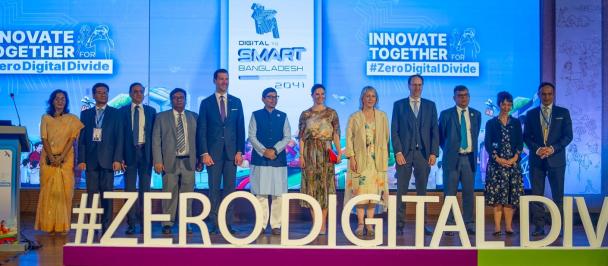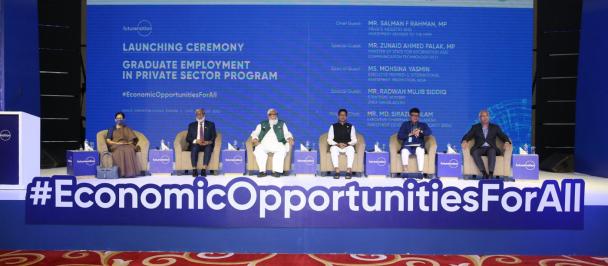Robert Stoelman,
UNDP
Lucy Turner,
UNDP
BY Robert Stoelman and Lucy Turner
The Blog was first published in The unstats.un.org Click here to read the original publication.
Remember when the world watched airplanes fly into the Twin Towers on 9/11? And again, the shock, the horror, the dreadful realization of the devastation of attacks in Paris, London and Madrid; Indonesia, Norway and New Zealand?
We remember, too.
On a Friday night in 2016 in Dhaka, Bangladesh, as patrons clinked glasses and enjoyed warm beguni, five militants burst into the Holey Artisan Bakery and opened fire. Armed with pistols, machetes, and crude bombs, the militants killed twenty-nine people.
The terrorist organization Jamaat-ul-Mujahideen organized the attack on-line—the same digital space where the grievances, misperceptions, and intolerance that led to the attack could be seen. This information could have been used to help prevent the attack, by informing action to promote tolerance, peace, justice and inclusion (SDG 16).
But this opportunity to save lives and safeguard progress towards the SDGs was missed, because there was no system to collect this data, and share it with the institutions who could use it in initiatives targeted to the people and places at greatest risk of violence.
The United Nations Development Programme (UNDP) decided to address this gap. The ‘Partnerships for a Tolerant and Inclusive Bangladesh (PTIB) project partnered with academic and private sector institutions (Dhaka University and SecDev) to leverage real-time data from millions of data points for evidence-based action to prevent violent extremism, and promote SDG 16. PTIB supports use of open source data analysis to identify specific incidences of violence, as well as the grievances that motivate engagement with hateful extremist narratives, and demographic characteristics of the people who engage with those narratives.
Drawing together diverse data sources—from official crime statistics to micro-narrative stories from rickshaw pullers, farmers, and small traders—through the power of open-source data analysis, the Dhaka University-based ‘Bangladesh Peace Observatory’ (BPO) has evolved from an idea to an institution that is identified as one of the country’s most respected data sources. BPO’s free and user-friendly public website is routinely used by government authorities, civil society organisations, academics, students, economists and foreign investors to design policies and projects, laws and budgets that promote peace and progress on the SDGs, and avoid attacks like the Holey Artisan Bakery. It appears to be working: there has been no attack of this scale in Bangladesh. The country has risen 2 places in the Human Development Index, and fallen 11 places on the Global Terrorism Index (which measures the impact of terrorism).
Bangladesh is a safer, more prosperous country than it was in 2016—even though other crises have rocked the nation since then. In 2018, when more than 700,000 Rohingya people fled to Bangladesh, PTIB used its networks and open-source data analysis expertise to inform the humanitarian response. The PTIB-supported Cox’s Bazaar Analysis and Research Unit (CARU) collects data and analysis from local (print) media and social media to identify refugee and host communities’ needs, track incidences of intolerance, and communicate this in short reports to inform crisis response efforts.
In 2020, when news of the COVID-19 virus first reached Bangladesh, UNDP-supported open-source data analysis teams rapidly adapted their work to understand the social impact of the pandemic. The first case was reported on 8th March; the first open-source data analysis reports were released on 1st April 2020; and throughout 2020, data and analysis produced by the Bangladesh Peace Observatory regularly appeared in national media headlines, where it informed national debates around the pandemic response. Former Foreign Secretary Shahidul Haque praised the Observatory for taking “a big step to fill the data gap” that had allowed misinformation to flourish, and organisations including UNICEF and the Australian Department of Foreign Affairs described how they used this open-source data analysis to inform their investments their investments in the SDGs in the changed, COVID-19 context.
Terrorist attacks. Pandemics. Infodemics. Refugee crises. In an unstable and unpredictable world, achieving ambitious goals like SDG 16 will require investments that are targeted to the people, places, and problems that need it most.
Data on peace, justice and inclusion from traditional sources like government administrative statistics, and development project surveys are no longer sufficient for this task: they are too time-consuming to collect, costly to undertake, and almost impossible to update regularly enough to ensure relevant action to prevent and respond to crisis. Open-source data analysis can help development actors move beyond clipboards and calls to police stations—even in the crisis-affected and underdeveloped contexts where electricity is in short supply and internet connections patchy. Often described along with buzz-words like ‘big data’ and ‘AI’, open-source data analysis refers to the use of free digital technology to analyze large quantities of data, in order to collect specific types of information—in this case, information relevant to peace, justice and inclusion (SDG 16). This type of information is available at-scale, within a short time-frame, and at relatively low cost, through open-source data analysis. And it can be used to significantly increase the impact of action to achieve SDG 16. For example, when UNDP’s PTIB project used information about violent extremist mindset and strategies to design initiatives to promote peace and celebrate diversity Bangladesh, engagement with those pro-tolerance and inclusion messages increased significantly, reaching more than eighteen million people directly, and achieving greatest engagement with the target group identified as most attracted to violent extremism content.
There are some secrets to realizing the promise of open source data analysis. First, sustainability and national ownership. UNDP’s PTIB project invests in national institutions with the capacities to use new technology and produce data and analysis.
Second, clear communication. PTIB prioritises production of compelling reports that include infographics, stories and statistics to make data easily understandable to, and useable by, non-statisticians.
Third, distribution. PTIB has established a clear framework for distributing data across government, civil society, media, UN and international organisations. PTIB also engages women’s organisations, youth entrepreneurs, human rights activists and community-based organisations to use data to strengthen the targeting and impact of their work to address the drivers of violent extremism, through peaceful, just and inclusive societies.

 Locations
Locations





